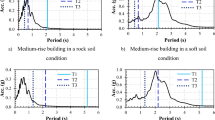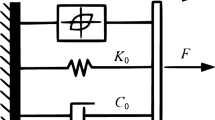Abstract
Real-time hybrid simulation evaluates the response of a structure in real time. In this study, a building with multi-story structure is divided into numerical and experimental substructures, and the vibration behavior of the experimental story is studied among the real-time simulation of the other stories. For applying the effect of static and inertial forces produced by the other stories to the experimental story, an electrohydraulic actuator and a shake table are used, respectively. The dynamics of the electrohydraulic actuator and the shake table can be estimated entirely by time delays, and these delays in the loop of simulation can reduce accuracy and cause system instability. Therefore, a delayed differential equation is used to determine the critical time delays depending on the system parameters. Results of simulation show the effect of non-dimensional parameters and time delays on the stability margin of hybrid simulation.
Similar content being viewed by others
References
V. Saouma and M. Sivaselvan, Hybrid Simulation: Theory, Implementation and Applications, CRC Press (2014).
M. Wallace, D. Wagg and S. Neild, An adaptive polynomial based forward prediction algorithm for multi-actuator realtime dynamic substructuring, Proceedings of the Royal Society of London A: Mathematical, Physical and Engineering Sciences, 461(2064) (2005) 3807–3826.
J.-Y. Tu, W.-D. Hsiao and C.-Y. Chen, Modelling and control issues of dynamically substructured systems: Adaptive forward prediction taken as an example, Proc. R. Soc. A, 470(2168) (2014) 20130773.
H. Zhou, D. J. Wagg and M. Li, Equivalent force control combined with adaptive polynomial-based forward prediction for real-time hybrid simulation, Structural Control and Health Monitoring, 24(11) (2017) e2018.
A. Reinhorn, M. Sivaselvan, S. Weinreber and X. Shao, Real-time dynamic hybrid testing of structural systems, Proceedings of 13th World Conference on Earthquake Engineering, Vancouver, Canada, No. 1644 (2004).
P. Gawthrop, D. Virden, S. Neild and D. Wagg, Emulator-based control for actuator-based hardware-in-the-loop testing, Control Engineering Practice, 16(8) (2008) 897–908.
T. Horiuchi and T. Konno, A new method for compensating actuator delay in real-time hybrid experiments, Philosophical Transactions of the Royal Society of London A: Mathematical, Physical and Engineering Sciences, 359(1786) (2001) 1893–1909.
R. Y. Jung and P. B. Shing, Performance evaluation of a real-time pseudodynamic test system, Earthquake Engineering & Structural Dynamics, 35(7) (2006) 789–810.
C. Chen and J. M. Ricles, Improving the inverse compensation method for real-time hybrid simulation through a dual compensation scheme, Earthquake Engineering & Structural Dynamics, 38(10) (2009) 1237–1255.
J. E. Carrion and B. F. Spencer Jr., Model-based Strategies for Real-time Hybrid Testing, 1940–9826, Newmark Structural Engineering Laboratory, University of Illinois at Urbana-Champaign (2007).
C. Chen and J. M. Ricles, Tracking error-based servohydraulic actuator adaptive compensation for real-time hybrid simulation, Journal of Structural Engineering, 136(4) (2010) 432–440.
X. Gao, N. Castaneda and S. J. Dyke, Real time hybrid simulation: from dynamic system, motion control to experimental error, Earthquake Engineering & Structural Dynamics, 42(6) (2013) 815–832.
G. Ou, A. I. Ozdagli, S. J. Dyke and B. Wu, Robust integrated actuator control: Experimental verification and realtime hybrid-simulation implementation, Earthquake Engineering & Structural Dynamics, 44(3) (2015) 441–460.
B. M. Phillips, S. Takada, B. Spencer and Y. Fujino, Feedforward actuator controller development using the backward-difference method for real-time hybrid simulation, Smart Structures and Systems, 14(6) (2014) 1081–1103.
N. M. Newmark, A method of computation for structural dynamics, Journal of the Engineering Mechanics Division, 85(3) (1959) 67–94.
B. Wu, G. Xu, Q. Wang and M. S. Williams, Operator-splitting method for real-time substructure testing, Earthquake Engineering & Structural Dynamics, 35(3) (2006) 293–314.
D. Combescure and P. Pegon, α-Operator splitting time integration technique for pseudodynamic testing error propagation analysis, Soil Dynamics and Earthquake Engineering, 16(7–8) (1997) 427–443.
S.-Y. Chang, Explicit pseudodynamic algorithm with unconditional stability, Journal of Engineering Mechanics, 128(9) (2002) 935–947.
B. Wu, Q. Wang, P. B. Shing and J. Ou, Equivalent force control method for generalized real-time substructure testing with implicit integration, Earthquake Engineering & Structural Dynamics, 36(9) (2007) 1127–1149.
C. Chen and J. M. Ricles, Development of direct integration algorithms for structural dynamics using discrete control theory, Journal of Engineering Mechanics, 134(8) (2008) 676–683.
Y. Gui, J.-T. Wang, F. Jin, C. Chen and M.-X. Zhou, Development of a family of explicit algorithms for structural dynamics with unconditional stability, Nonlinear Dynamics, 77(4) (2014) 1157–1170.
J. Chung and G. Hulbert, A time integration algorithm for structural dynamics with improved numerical dissipation: The generalized-α method, Journal of Applied Mechanics, 60(2) (1993) 371–375.
C. Kolay, J. M. Ricles, T. M. Marullo, A. Mahvashmohammadi and R. Sause, Implementation and application of the unconditionally stable explicit parametrically dissipative KR-α method for real-time hybrid simulation, Earthquake Engineering & Structural Dynamics, 44(5) (2015) 735–755.
M. Ahmadizadeh, G. Mosqueda and A. Reinhorn, Compensation of actuator delay and dynamics for real-time hybrid structural simulation, Earthquake Engineering & Structural Dynamics, 37(1) (2008) 21–42.
A. Darby, M. Williams and A. Blakeborough, Stability and delay compensation for real-time substructure testing, Journal of Engineering Mechanics, 128(12) (2002) 1276–1284.
B. Wu, Z. Wang and O. S. Bursi, Actuator dynamics compensation based on upper bound delay for real-time hybrid simulation, Earthquake Engineering & Structural Dynamics, 42(12) (2013) 1749–1765.
P. Shi, B. Wu, B. F. Spencer Jr., B. M. Phillips and C. M. Chang, Real-time hybrid testing with equivalent force control method incorporating Kalman filter, Structural Control and Health Monitoring, 23(4) (2016) 735–748.
T. Horiuchi, M. Inoue, T. Konno and Y. Namita, Real-time hybrid experimental system with actuator delay compensation and its application to a piping system with energy absorber, Earthquake Engineering & Structural Dynamics, 28(10) (1999) 1121–1141.
M. Wallace, J. Sieber, S. Neild, D. Wagg and B. Krauskopf, Stability analysis of real-time dynamic substructuring using delay differential equation models, Earthquake Engineering & Structural Dynamics, 34(15) (2005) 1817–1832.
Y. Kyrychko, K. Blyuss, A. Gonzalez-Buelga, S. Hogan and D. Wagg, Real-time dynamic substructuring in a coupled oscillator-pendulum system, Proceedings of the Royal Society of London A: Mathematical, Physical and Engineering Sciences, 462(2068) (2006) 1271–1294.
O. Mercan and J. M. Ricles, Stability analysis for real-time pseudodynamic and hybrid pseudodynamic testing with multiple sources of delay, Earthquake Engineering & Structural Dynamics, 37(10) (2008) 1269–1293.
F. Chi, J. Wang and F. Jin, Delay-dependent stability and added damping of SDOF real-time dynamic hybrid testing, Earthquake Engineering and Engineering Vibration, 9(3) (2010) 425–438.
R. M. Botelho and R. E. Christenson, Robust stability and performance analysis for multi-actuator real-time hybrid substructuring, Dynamics of Coupled Structures, Springer, 4 (2015) 1–7.
C. Chen and J. M. Ricles, Stability analysis of SDOF real-time hybrid testing systems with explicit integration algorithms and actuator delay, Earthquake Engineering & Structural Dynamics, 37(4) (2008) 597–613.
F. Zhu, J. T. Wang, F. Jin, F. D. Chi and Y. Gui, Stability analysis of MDOF real-time dynamic hybrid testing systems using the discrete-time root locus technique, Earthquake Engineering & Structural Dynamics, 44(2) (2015) 221–241.
A. Maghareh, S. J. Dyke, A. Prakash and G. B. Bunting, Establishing a predictive performance indicator for real-time hybrid simulation, Earthquake Engineering & Structural Dynamics, 43(15) (2014) 2299–2318.
A. Maghareh, S. Dyke, S. Rabieniaharatbar and A. Prakash, Predictive stability indicator: a novel approach to configuring a real-time hybrid simulation, Earthquake Engineering & Structural Dynamics, 46(1) (2017) 95–116.
M. Paz, Structural Dynamics: Theory and Computation, Springer Science & Business Media (2012).
P. Gawthrop, M. Wallace, S. Neild and D. Wagg, Robust real-time substructuring techniques for under-damped systems, Structural Control and Health Monitoring: The Official Journal of the International Association for Structural Control and Monitoring and of the European Association for the Control of Structures, 14(4) (2007) 591–608.
J. Zhao, C. French, C. Shield and T. Posbergh, Considerations for the development of real-time dynamic testing using servo-hydraulic actuation, Earthquake Engineering & Structural Dynamics, 32(11) (2003) 1773–1794.
Author information
Authors and Affiliations
Corresponding author
Additional information
Recommended by Associate Editor Hyeong-Joon Ahn
Mostafa Nasiri received his M.S. in aerospace engineering from Sharif University of Technology, Tehran, Iran, in 2002 and his Ph.D. in mechanical engineering from Iran University of Science and Technology (IUST), Tehran, Iran, in 2012. Since 2013, he has been Assistant Professor of mechanical engineering at Golpayegan University of Technology (GUT), Isfahan, Iran. His current studies include flight control and simulation, jet engine control systems, automation, hardware-in-the-loop simulation, real-time hybrid simulation, networked control systems, and time-delay compensation of delayed systems.
Ali Safi received his B.S. in mechanical engineering from Golpayegan University of Technology (GUT), Isfahan, Iran, in 2018. At present, he is an M.S. student of mechanical engineering at Iran University of Science and Technology (IUST), Tehran, Iran. His research interests are mechatronics, automation, and control.
Rights and permissions
About this article
Cite this article
Nasiri, M., Safi, A. Stability analysis of real-time hybrid simulation in consideration of time delays of actuator and shake table using delay differential equations. J Mech Sci Technol 33, 1489–1499 (2019). https://doi.org/10.1007/s12206-019-0301-6
Received:
Revised:
Accepted:
Published:
Issue Date:
DOI: https://doi.org/10.1007/s12206-019-0301-6




